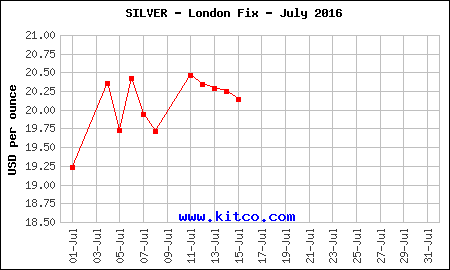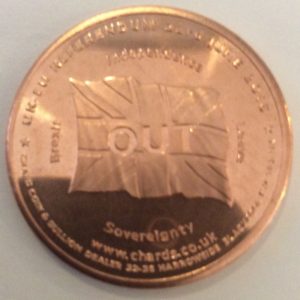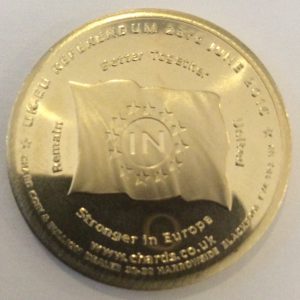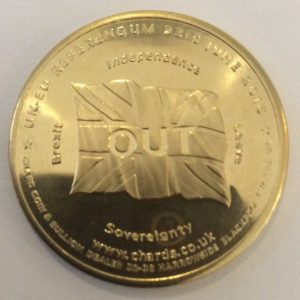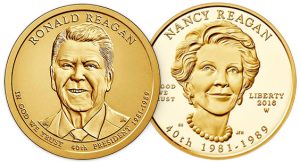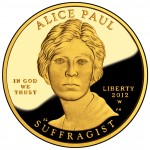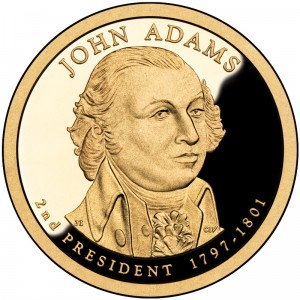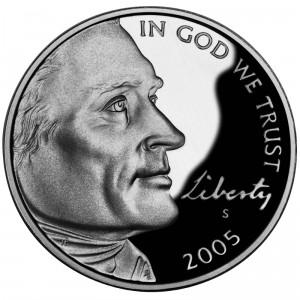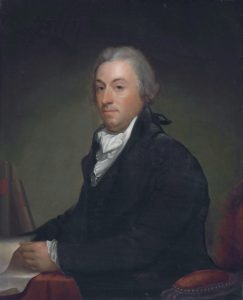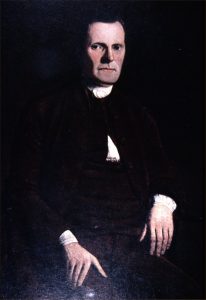Weekly World Numismatic News for May 9, 2021
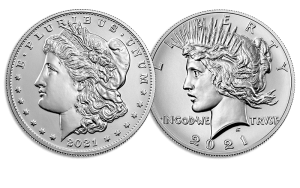 There were two other news items that collectors should be aware. Last week, the ANA held an online Candidates Forum. Only one of the candidates did not attend.
There were two other news items that collectors should be aware. Last week, the ANA held an online Candidates Forum. Only one of the candidates did not attend.
The forum demonstrated two types of candidates: the status quo and those who want to do something. The status quo candidates refused to think outside of the proverbial box and look to continue using the same methods that have not advanced the ANA beyond its current state. The others have different ideas to move the ANA forward.
Few of the candidates have ideas discussed in the past but taking advantage of the current climate. These are the candidates that need to be elected to the ANA Board of Governors. A full review of the Candidates Form is forthcoming.
Another bit of news was a May 4 conference call by the U.S. Mint with members of the media. Even though I asked questions they answered during that conference call the previous week, I was not invited to participate. There are additional questions that the U.S. Mint did not address, which I sent via email. The U.S. Mint has not answered those questions.
I will wait a few days for the U.S. Mint to answer my questions before explaining how they do not care about the collectors and what I suggest the community can do to correct their behavior.
And now the news…
 → Read more at washingtonpost.com
→ Read more at washingtonpost.com → Read more at kitco.com
→ Read more at kitco.com → Read more at northjersey.com
→ Read more at northjersey.com → Read more at sciencedaily.com
→ Read more at sciencedaily.com → Read more at barrons.com
→ Read more at barrons.com
A Token of Brexit
A few weeks ago I wrote about the potential effects of Brexit on markets should the Brits vote to leave the European Union. When the OUT vote won by a slim margin, there was an instant worldwide reaction. In the subsequent weeks, we have seen world markets react to everything. After an initial fall in markets because of Brexit they have recovered only to be sent back into uncertainty with world events.
The London PM Gold Fix was $1,265.12 before the polls closed on June 23. The next day, the London PM Gold Fix closed at $1,315.50 (4-percent increase). On July 15, the PM Gold Fix closed at $1,327.00, 4.9-percent increase since the vote. Experts are saying gold could continue to climb at the 4-percent rate for the near future.
Silver has been on a slow and steady rise for most of the spring also saw a bump following the Brexit vote. When the London Silver Fix closed at $17.29 on June 23, this was already a $3.29 increase (23.5-percent) from the January 4 first close of 2016 price of $14.00. After the results were announced, London Silver Fix closed at $18.04, a 4.3-percent increase. With the London Silver Fix closing at $20.14 on July 15 (16.48-percent increase), some pundits are suggesting that silver will continue to outperform gold for the near future.
- Kitco Gold Chart as of 8/15/16
- Kitco Silver Chart as of 8/15/16
When I wrote about Brexit, I also mentioned the “In/Out UK EU Referendum Medallion” produced by Chard(1964), a British metals dealer. After the post, the folks at Chard saw a small bump in sales from collectors the United States from a few of my readers. I was not paid to mention the medal. I just found the information online and thought it was an interesting idea. Shortly before the vote, someone at Chard contacted me and offered to send me some medals.
After a swim across the pond, the medals arrived in my physical mail last weekend. Even though I thought Brexit was a bad idea, the medals are still very cool. Design is the same on both medals. One is copper and the other is Abyssinian Gold, a type of brass made of 90-percent copper and 10-percent zinc that has a gold-like color. Medals are 31mm in diameter and weighs 14 grams making it a nice sized coin for flipping.
- Chard Brexit copper token—IN side
- Chard Brexit copper token—OUT side
- Chard Brexit Abyssinian Gold token—IN side
- Chard Brexit Abyssinian Gold token—OUT side
Chard sent two sets of the medals. I will keep one set and donate the other to my coin club’s annual auction whose proceeds will benefit the Scouts and other numismatic-related education in our region.
It appears that these medals can still be purchased for £2.95 each ($4.33 at the current exchange rate) plus shipping (estimated at £6.00 or $8.80) directly from Chard’s website. I am not making money from this endorsement. I just think it’s a fun collectible!
POLL: What do you collect?
I am asking for two reasons: first, I am curious. I know that my tastes are different from yours and I am curious about yours. There is no wrong answer to this question because whatever you like to collect is right for you. It should not matter what anyone thinks of your collection because it’s your collection and you are the one that has to be happy with it. I want to know what makes you happy.
The second reason is so I know a little about who is reading the my blog. It will allow me to could tailor some content to your tastes. It is good for me to stretch out of my comfort zone a bit to learn about something else. But I want to do so in a way that I can write about it and someone will have an appreciation for the content.
The poll is anonymous. The usual set of website logs are kept on the server but it does not identify you or how you voted. Comments are encouraged and moderated only to prevent spam. If you are reading this from a site that aggregates web content, you will have to visit the page on my site in order to participate.
BREAKING NEWS: Rosie Rios Last Day

Former Treasurer of the United States Rosie Rios
“Rosie Rios joined the Treasury team nearly eight years ago, during the presidential transition. Since then, she has been a thoughtful steward of two important Treasury bureaus — the Bureau of Engraving and Printing and the Mint — and has been an advocate for women and girls including, for example, her leadership of the Treasury Women in Finance symposium.
“I am particularly grateful for her creativity and leadership in the effort to redesign our paper currency and to ensure that future notes reflect, for the first time in 120 years, the important role of women in shaping our democracy. I thank her for her service and wish her all the best in her future endeavors.”
As the 43rd Treasurer, Rios has been an advocate for everything regarding her oversight of the U.S. Mint and Bureau of Engraving and Printing including her participation at shows. Aside from her signature appearing on every Federal Reserve Note since the 2009 Series, she continued to autograph notes for collectors at conventions. She jokingly calls them “Rosie Dollars.”

Series 2009 Federal Reserve Note autographed by Treasurer of the U.S. Rosa Gumataotao Rios
Rios has worked as a business executive prior to working on the Obama campaign in 2008 in Virginia. She was hired to work with the transition team on matters concerning the Treasury Department and then was nominated as Treasurer. Rios has been serving as Treasurer since August 8, 2009.
Her future plans were not announced.
Aside from being a tough act to follow, the position may stay vacant for a while. Given the hyper-partisan nature of congress and that we are heavy into this election cycle, it is highly unlikely that the Senate would consider confirming an Obama appointment. Currently, Rhett Jeppson is waiting for a vote to confirm his appointment to be the 39th Director of the U.S. Mint. Jeppson’s nomination was sent to the Senate for “advise and consent” on July 9, 2016. A hearing about his nomination was held on March 15, 2016. The nomination remains in committee waiting for the Senate to do their job and hold a vote.
Riding off into the sunset
On the Friday before the Independence Day celebration weekend, the U.S. Mint released the Ronald Reagan dollar and Nancy Reagan first spouse coin marking the end of the program.
The Presidential Dollar program has had an interesting history. Passed by congress in December 2005 and later signed by President George W. Bush, the Presidential $1 Coin Act (Pub. L. 108-145) ordered the U.S. Mint to create a $1 coin to commemorate the Nation’s past Presidents and an accompanying $10 gold coin to commemorate the President’s spouse (First Lady). Coins appeared in order that the president served and the president must be deceased for two year prior to the coin’s issue. Since Jimmy Carter is still living, he was bypassed and the last coin was for Ronald Reagan.
First Spouse gold coin, they bore the image of the first spouse of the corresponding president with historical information about the spouse on the reverse are issued for each spouse. For the cases where the president was widowed prior to taking office, the obverse of a contemporary coin was used and a historical image is used on the reverse. The only exception was the 2012 coin honoring Alice Paul to coincide with the Chester A. Arthur presidential dollar. Since Arthur was widowed prior to his inauguration, the law gave the honor to Alice Paul, a suffragette who was born during Arthur’s administration. The program ended with the issue of the Nancy Reagan coin.For the first time in the modern era the date, mintmark, and mottos “E Pluribus Unum” and “In God We Trust” struck into (incuse) the edge of the coin. The last time edge lettering was used on circulating U.S. coinage was in the 1790s.
With the edge lettering a new process for the U.S. Mint, it was no surprised that coins left the Mint without the mottos stamped in the edge. Dubbed the “godless dollar” the error caused an uproar over some people suggesting that the government was conspiring against religion by leaving the motto off of the coin. This was described as either a willful omission or a way to attack religion. There was no narrative that accepted that this was just a mistake.
Our national nightmare ended when congress updated the law (Pub. L. 110-161) to move the motto from the edge to the obverse of the coin. E Pluribus Unum, the date and mintmark was left on the edge.
Then there was the breathless story by National Public Radio that decried the tax dollars being wasted by the approximately $1.4 Billion of dollar coins being stored in the Federal Reserves’ vaults. The story was filled with partial truths and did not properly explain the situation. When I tried to reach out to NPR, I was rebuffed by a reporter who decided a low-level Treasury staffer who did not have the first clue about reality was more credible
While the media was blaming the U.S. Mint and the Federal Reserve, they forgot to read the law. According to the law, there were mintage minimums that congress wrote into the law including the one that said the Sacagawea dollar was to comprise one-third of the dollar coin production. As part of the legislation, the U.S. Mint and Federal Reserve were supposed to promote the coin’s use and provide educational materials for the public.
Congress, who wrote and passed the original legislation, was tripping all over themselves to introduce bills to end the program while pounding their collective chests claiming they were acting in the public interest.
This nightmare ended when then Treasury Secretary Tim Geithner ordered a reduction in the production of all dollar coins. None of the bills introduced to eliminate the dollar coin were ever heard in committee and died at the end of the 113th congress.
But the series couldn’t continue without one more controversy. The way the law was written, it was interpreted that it would end with the first living president. In this case, the program would have ended with the coin honoring Gerald Ford since Jimmy Carter is still living. This did not sit well with the fans of Ronald Reagan who have spent the time since his convalescence and death trying to plaster his name all over everything including an airport that employed air traffic controllers he fired placing the nation’s skies at risk.
The same members of congress that introduced bills to eliminate the program were now demanding the program be extended by one president. Ironically, they waited until after the resignation of Mint Director Edmund Moy and approached the acting Director Richard Peterson. Although Peterson was named acting director, he was a career government employee with impeccable credentials but had to have a different relationship with the politicians than an appointed director would. The matter was deferred to Treasurer Rosie Rios and Secretary of the Treasury Jack Lew who approved the extension of the program.
Presidential Dollars
- 2007:
- George Washington, John Adams, Thomas Jefferson, James Madison
- 2008:
- James Monroe, John Quincy Adams, Andrew Jackson, Martin Van Buren
- 2009:
- William Henry Harrison, John Tyler, James K. Polk, Zachary Taylor
- 2010:
- Millard Fillmore, Franklin Pierce, James Buchanan, Abraham Lincoln
- 2011:
- Andrew Johnson, Ulysses S. Grant, Rutherford B. Hayes, James Garfield
- 2012:
- Chester A. Arthur, Grover Cleveland, Benjamin Harrison, Grover Cleveland
- 2013:
- William McKinley, Theodore Roosevelt, William Howard Taft, Woodrow Wilson
- 2014:
- Warren Harding, Calvin Coolidge, Herbert Hoover, Franklin D. Roosevelt
- 2015:
- Harry S Truman, Dwight D. Eisenhower, John F. Kennedy, Lyndon B. Johnson
- 2016:
- Richard M. Nixon, Gerald Ford, Ronald Reagan
First Spouse Gold $10 Coins
- 2007:
- Martha Washington, Abigail Adams, Thomas Jefferson’s Liberty,† Dolley Madison
- 2008:
- Elizabeth Monroe, Louisa Adams, Andrew Jackson’s Liberty,† Martin Van Buren’s Liberty†
- 2009:
- Anna Harrison, Letitia Tyler,‡ Julia Tyler,†† Sarah Polk, Margaret Taylor
- 2010:
- Abigail Fillmore, Jane Pierce, James Buchanan’s Liberty,* Mary Lincoln
- 2011:
- Eliza Johnson, Julia Grant, Lucy Hayes, Lucretia Garfield
- 2012:
- Alice Paul,¶ Frances Cleveland (first term), Caroline Harrison,‡ Frances Cleveland (second term)
- 2013:
- Ida McKinley, Edith Roosevelt, Helen Taft, Ellen Wilson,‡ Edith Wilson††
- 2014:
- Florence Harding, Grace Coolidge, Lou Hoover, Anna Eleanor Roosevelt
- 2015:
- Elizabeth Truman, Mamie Eisenhower, Jacqueline Kennedy, Claudia Taylor “Lady Bird” Johnson
- 2016:
- Patricia Ryan “Pat” Nixon, Betty Ford, Nancy Reagan
- †
- President was widowed prior to inauguration
- ‡
- First Spouse died during the president’s term
- ††
- Married the president during the president’s term
- *
- James Buchanan was the only bachelor president
- ¶
- President Chester Arthur was widowed prior to inauguration. However, the authorizing law gives the coin honor to Alice Paul, a suffragette who was born during Arthur’s administration
When the Reagan dollar was issued, 39 presidents representing 40 terms were issued.
Along with Nancy Reagan, 35 other first spouses were honored (Frances Cleveland appeared twice), four different Liberty coins were issued, and one was issued to honor suffragette Alice Paul.

President Reagan horseback riding at Rancho del Cielo with Freebo (his daughter’s dog) and Victory the golden retriever following.
As the program now quietly rides off into the proverbial sunset, maybe it is time to let the America the Beautiful Quarters® complete their run through 2021 and give the circulating commemoratives a rest.
- Coin images courtesy of the U.S. Mint
- Reagan on horsback “April 4, 1986 photo courtesy Ronald Reagan Presidential Library and Museum.” Downloaded from PresidentialPetMuseum.com
240 Years Before Brexit
After nearly a year of war and attempted negotiation with King George III and the British parliament, it became clear that the colonies in the New World would continue to be under harsh rule without representation. In January 1776, the Continental Congress met to discuss the matter.
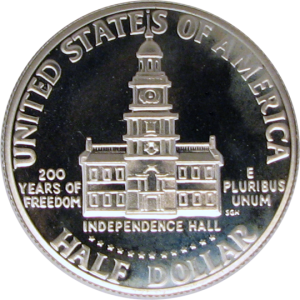 Public support for independence from the British Empire was growing amongst the colonies. Only the “middle colonies” of New York, New Jersey, Delaware, and Maryland who were benefiting financially being part of the British Empire were against independence. When these colonies sent delegations to the Continental Congress, each of their conventions did not allow them to vote for independence.
Public support for independence from the British Empire was growing amongst the colonies. Only the “middle colonies” of New York, New Jersey, Delaware, and Maryland who were benefiting financially being part of the British Empire were against independence. When these colonies sent delegations to the Continental Congress, each of their conventions did not allow them to vote for independence.
As the war with Great Britain dragged on and the attempt at tightening their reigns on the colonies persisted, the populous cry for independence grew. Delegates were set back to their governments and representatives sent to the middle colonies to convince them that the colonies had to declare independence for their own survival. As colonies began to line up with the independence movement, Pennsylvania, New York, Maryland, and South Carolina remained reticent on the subject.
Of the four hold outs, Pennsylvania and Maryland had governments with strong ties to the colonial governors who still had influence. John Adams wrote a draft preamble to explain the independence resolution. Part of the way the resolution was written was, in effect, to overthrow the colonial governments of Pennsylvania and Maryland so that it would be replaced by a popular government. On May 15, 1776, that preamble was passed. The colonies had taken their first step toward independence.
Delegates left the congress and returned to their own colonial conventions. Maryland, whose delegates walked out of the congress in protest, continued to reject the notion of independence. Samuel Chase returned to Maryland and convinced them to allow their delegates to approve the motion of independence. Pennsylvania, New York, and South Carolina remained against the declaration while the Delaware delegates were split.
On June 11, 1776, the “Committee of Five” was appointed to draft a declaration. Committee members were John Adams of Massachusetts, Benjamin Franklin of Pennsylvania, Thomas Jefferson of Virginia, Robert R. Livingston of New York, and Roger Sherman of Connecticut. Although no minutes were kept from the committee meetings, it was accepted that the resulting document was largely Jefferson’s work. The Committee of Five completed the draft on June 28, 1776.
- Robert R. Livingston
- Roger Sherman
Debate on the draft declaration began on July 1. After a long day of speeches a vote was taken. Maryland voted yes but Pennsylvania and South Carolina voted no. The New York delegation abstained with out authority from their government to vote. Delaware could not vote because its delegate was split on the question. Edward Rutledge of South Carolina moved to postpone the vote until the next day.
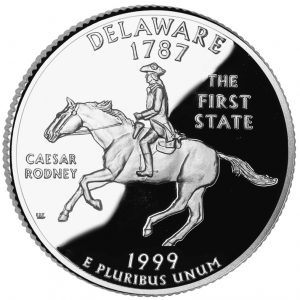 Although there is no written history on what happened that evening, there had to have been lobbying by supporters of independence because on July 2, South Carolina voted yes followed by a turnaround by the Pennsylvania delegation that also voted yes. New York with no authority from their government continued to abstain. With the Delaware delegation deadlocked, this set up the historical ride of Caesar Rodney. Rodney was one of Delaware’s representative to the Continental Congress. He was in Dover attending to other business when he learned that Thomas McKean and George Read were deadlocked on the vote of independence. Rodney rode 80 miles from Dover to Philadelphia to vote with McKean to allow Delaware join eleven other colonies voting in favor of independence.
Although there is no written history on what happened that evening, there had to have been lobbying by supporters of independence because on July 2, South Carolina voted yes followed by a turnaround by the Pennsylvania delegation that also voted yes. New York with no authority from their government continued to abstain. With the Delaware delegation deadlocked, this set up the historical ride of Caesar Rodney. Rodney was one of Delaware’s representative to the Continental Congress. He was in Dover attending to other business when he learned that Thomas McKean and George Read were deadlocked on the vote of independence. Rodney rode 80 miles from Dover to Philadelphia to vote with McKean to allow Delaware join eleven other colonies voting in favor of independence.
With 12 votes for independence and one abstention, the Continental Congress approved the declaration. Jefferson then set forth to make the agreed upon corrections to the document. On July 4, 1776, the Continental Congress approved the wording of the Declaration of Independence. The document was sent to the printer for publication and distribution to the public.
Although historians debate exactly when the final document was signed, it is accepted that the final signatures were added on August 2, 1776. Since New York approved the resolution of independence on July 10, the New York delegation is included amongst the signatures.
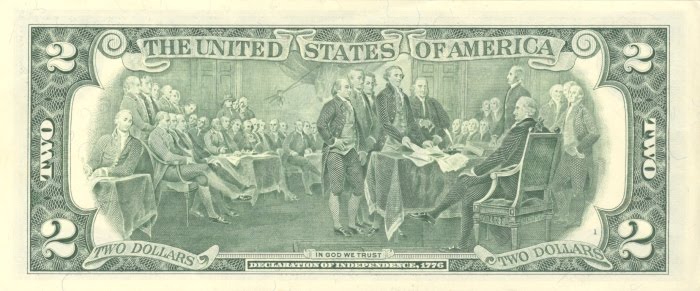

- “Declaration of Independence” by John Trumbull hangs in the U.S. Capitol Rotunda and was used as the model for the reverse of the $2 Federal Reserve Note. Image courtesy of Wikipedia.
- Bicentennial half-dollar reverse and Franklin half-dollar images courtesy of the author.
- All other coin images courtesy of the U.S. Mint
- All other images courtesy of Wikipedia.


